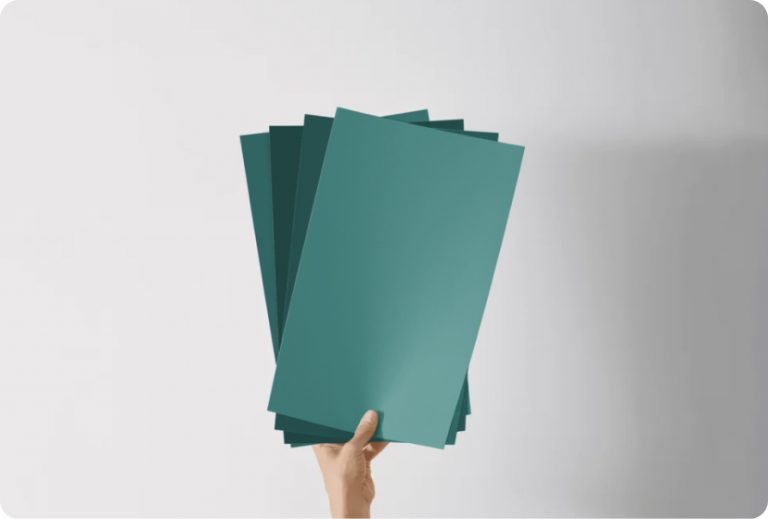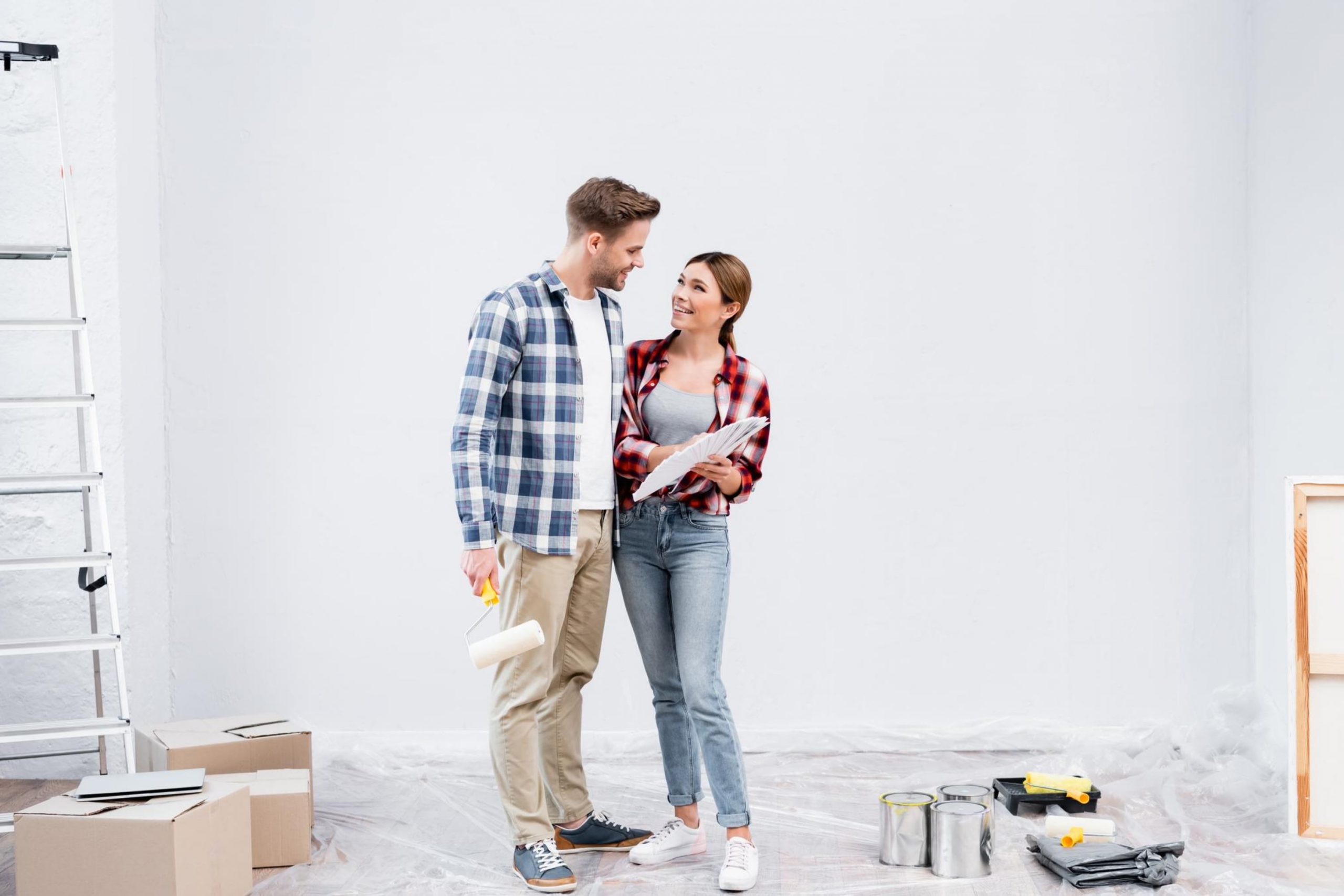Finding the perfect red can be a challenge, but Sherwin Williams’ SW 6871 Positive Red stands out as a vibrant and energetic choice. In my search for a red that could really brighten up a room without overpowering it, I came across this shade. As I used it in various projects, I noticed how it brings life and a touch of excitement to rooms that need a little uplift. It has a balanced tone that doesn’t lean too much toward orange or purple, which makes it easy to use with many other colors
Whether you’re looking to jazz up a kitchen or add some warmth to a living room, SW 6871 Positive Red could be the go-to color you need. Its rich hue works well with different lighting conditions, maintaining its lively character without fading into the background. This color pairs perfectly with neutral tones, creating a clean and bold look that feels well put together.
I found it particularly useful in modern decor schemes that benefit from a splash of color. If you’re hesitant about introducing a bold red into your home, consider using it on a feature wall or as part of a pattern with other complementary colors.
I’ve tried it both ways and always appreciate the instant pop of energy it adds to any room.
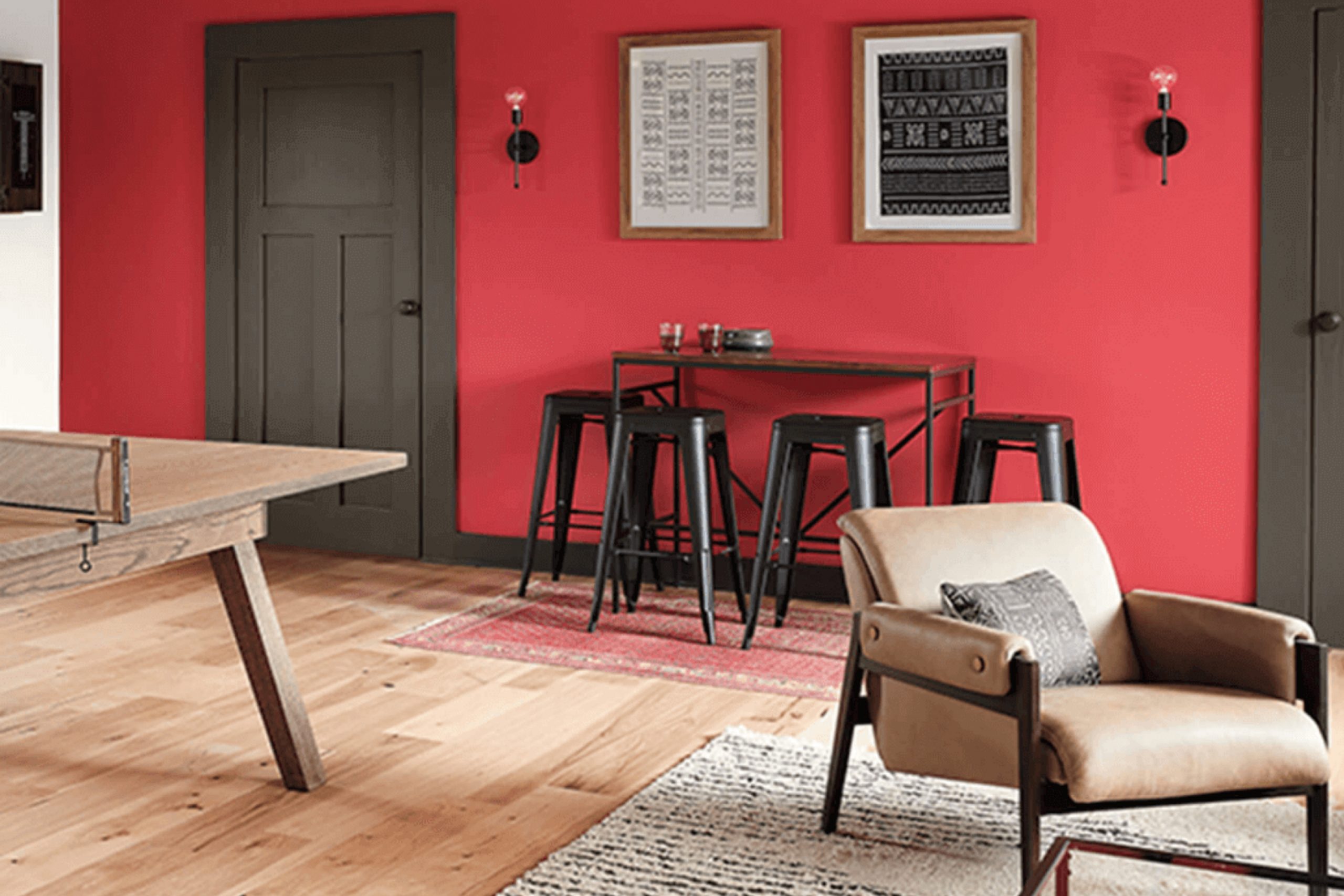
What Color Is Positive Red SW 6871 by Sherwin Williams?
Positive Red by Sherwin Williams is a vibrant and energetic hue, perfect for adding a bold statement to any room. Its lively nature makes it an ideal choice for rooms that benefit from a touch of excitement and cheerfulness. This color possesses a deep, rich quality that can make other elements in the room stand out, particularly when used as an accent wall or a focal point.
In terms of interior styles, Positive Red works best with modern and contemporary designs where clean lines and bright colors are prominent. It also fits well in eclectic rooms where a mix of colors and textures creates a playful and dynamic environment. For a retro vibe, combining it with teal or mustard yellow can recreate the lively spirit of mid-century modern decor.
When it comes to materials, Positive Red pairs beautifully with natural wood, adding warmth to the boldness of the red. It also looks stunning against metal finishes like brushed nickel or stainless steel, which provide a modern touch and enhance the intensity of the red. For textures, soft, plush fabrics like velvet or silk can soften the strong presence of red, making the spot more inviting and comfortable.
In summary, Positive Red is a bold, lively color that can brighten up any spot. It pairs well with different materials and styles, helping you create a look that feels both eye-catching and inviting.
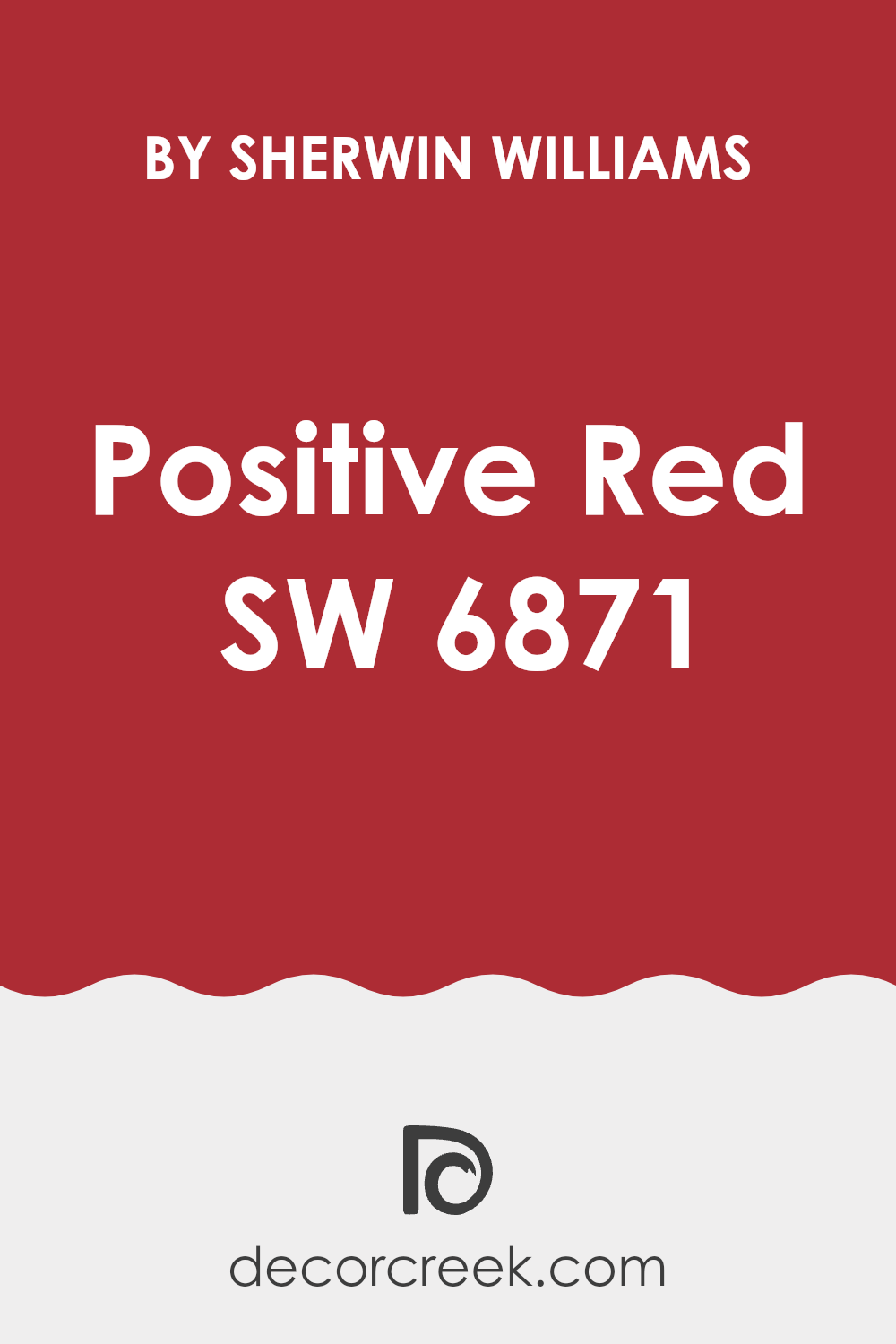
Is Positive Red SW 6871 by Sherwin Williams Warm or Cool color?
Positive Red SW 6871 by Sherwin Williams is a vibrant and bold color that brings energy and warmth into any home. This bright red shade can create a strong focal point in a room, especially when used on an accent wall or for key pieces of furniture. The color works well in living rooms or dining areas where activity is high and a lively atmosphere is desired.
Using Positive Red in a home can also stimulate conversation and feelings of excitement, making it a great choice for social areas. However, since it’s so vibrant, it’s best to pair it with neutrals like white, gray, or beige to keep the look balanced and easy on the eyes
In smaller doses, such as in decorative accents or a single painted wall, Positive Red can add just the right amount of pop and personality to a room without dominating it. Overall, it’s a fantastic color choice for anyone looking to add a splash of warmth and vitality to their living environment.
Undertones of Positive Red SW 6871 by Sherwin Williams
Positive Red by Sherwin Williams is a vibrant and bold color that adds energy and warmth to any spot. When talking about colors, the term “undertones” refers to the subtle hints of other colors that can be seen within the main color. These undertones play a crucial role in changing the way we perceive the main color. In the case of Positive Red, its undertones include shades of brown, pink, purple, orange, olive, pale pink, and grey.
Each undertone influences how Positive Red looks depending on the lighting and surrounding colors. For example, brown and orange undertones can make the red appear warmer and more inviting, perfect for living rooms or dining areas. Pink and purple undertones might give it a slightly softer look, ideal for rooms that aim for a cheerful yet not overpowering ambiance.
On interior walls, these undertones enable Positive Red to interact dynamically with different furniture and decor styles. In natural light, the color might lean more towards its orange or pink undertones, bringing a fresh and lively feel. Under artificial lighting, the brown or grey undertones could become more pronounced, providing a grounded and cozy atmosphere.
In summary, the undertones of Positive Red help it adjust well to different settings and moods, making it easy to use in many parts of the home. This adaptability makes it an excellent option for anyone looking to introduce a splash of color that is vibrant yet harmonious with the rest of their decor.
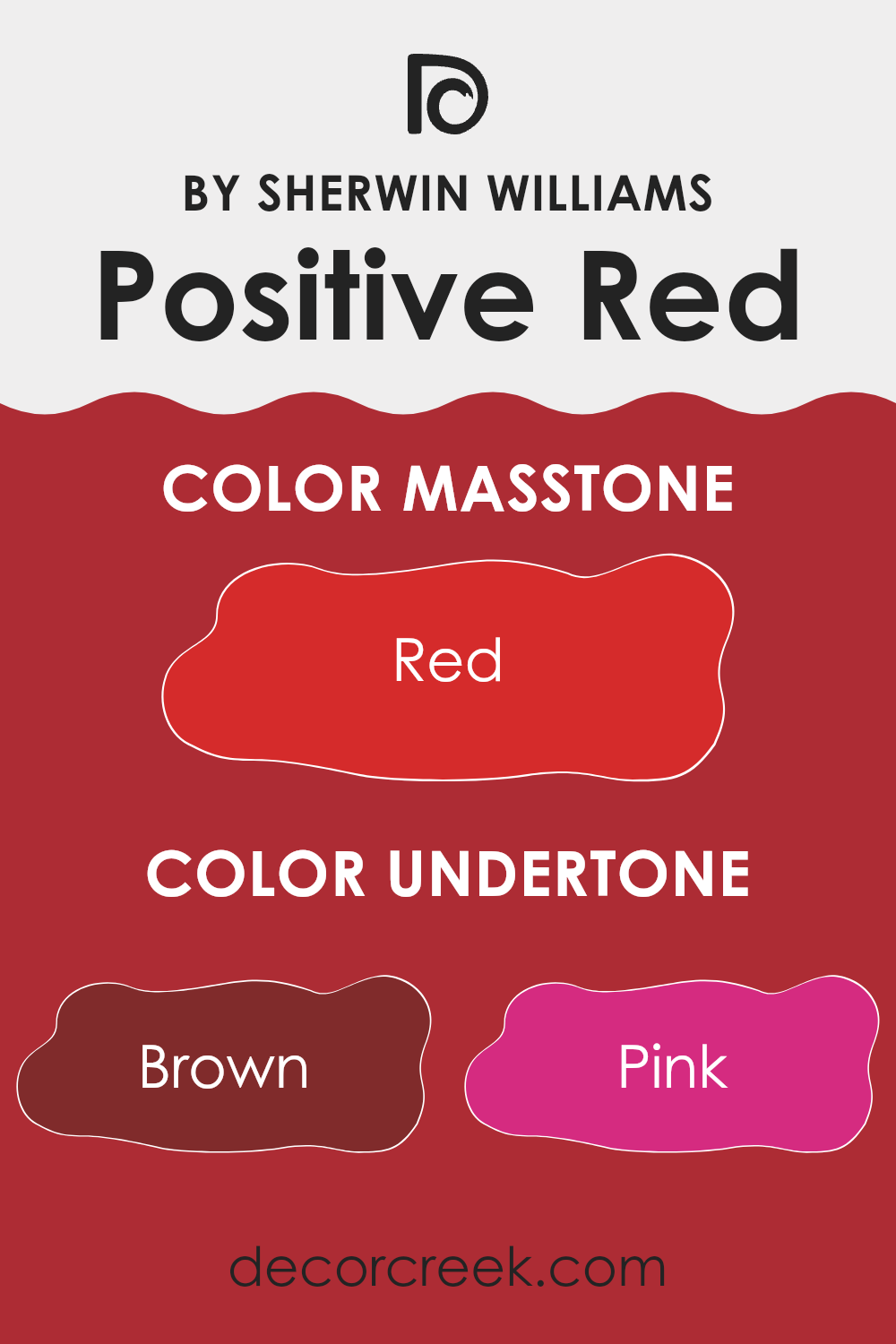
What is the Masstone of the Positive Red SW 6871 by Sherwin Williams?
Positive Red (#D52B2B) by Sherwin Williams is a vibrant and rich shade of red that brings a strong and energetic presence into any home. This particular red has a warmth and brightness that can make rooms feel more lively and inviting. Because it is a bold color, it works best in areas where you want to create a focal point or add a burst of energy. For instance, an accent wall painted with Positive Red can turn a plain room into a more dynamic and interesting spot.
In living rooms or dining areas, this color can stimulate conversation and social interaction, making it perfect for rooms meant for gathering. In smaller doses — like on a piece of furniture or in accents — it adds a fun pop of color without making the area feel too bold
Because of its boldness, it’s important to balance this red with neutral colors like white, gray, or beige. This helps to ensure that the room feels balanced and not too intense. Using Positive Red in a home requires a thoughtful approach to keep the environment welcoming and lively.
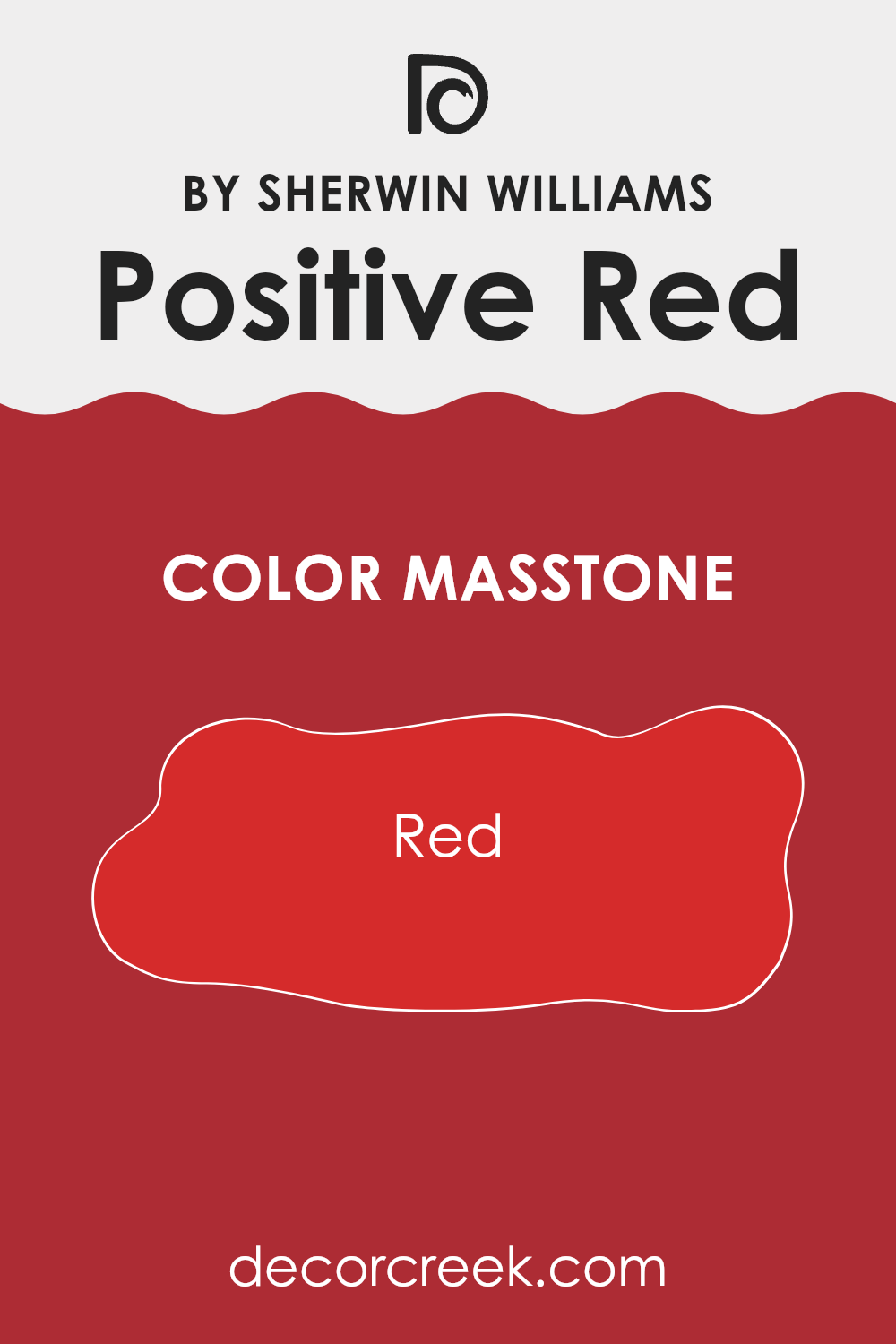
How Does Lighting Affect Positive Red SW 6871 by Sherwin Williams?
Lighting plays a crucial role in how we perceive colors in our environments. Different types of light, whether natural or artificial, can greatly influence how a shade looks in a spot. For instance, Positive Red, a vibrant shade by Sherwin Williams, can appear differently under various lighting conditions.
In artificial light, Positive Red tends to look richer and more intense. This is because most artificial lighting emits a yellowish hue, enhancing warm colors like red. In rooms with fluorescent lighting, which is cooler, this red might appear slightly more subdued, with a sharper tone.
Under natural light, Positive Red will change throughout the day depending on the sunlight’s direction and intensity. In north-facing rooms, which receive less direct sunlight and more cool, indirect light, Positive Red may appear more muted and subtle. In contrast, in a south-facing room, which gets abundant direct sunlight, this shade will appear brighter and more vivid, almost glowing with warmth.
In east-facing rooms, where sunlight is bright in the morning and softer later in the day, Positive Red will start the day brightly and gradually become softer as the day progresses. This makes it feel welcoming in the morning while still maintaining a pleasant appearance in the afternoon.
In west-facing rooms, the color will display the opposite behavior. It will look more subdued in the morning when the light is cooler and become very dynamic and vivid in the evening as the sun sets. Understanding these subtle shifts can help in deciding where and how to use this vibrant red color in home or office rooms to make the most of its dynamic properties under varying lighting conditions.
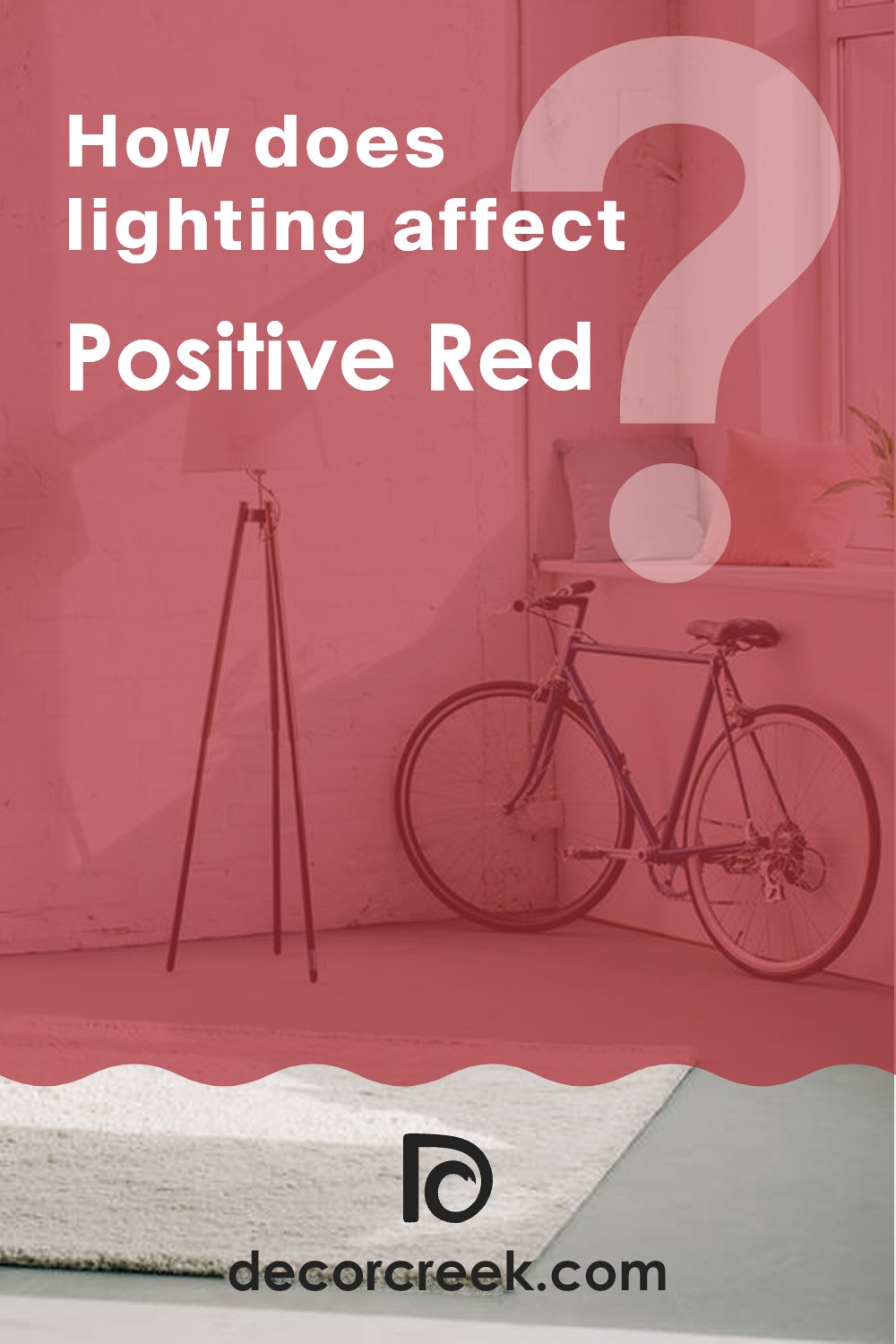
What is the LRV of Positive Red SW 6871 by Sherwin Williams?
LRV stands for Light Reflectance Value, a measure used to express the percentage of light that a paint color reflects back into a room as opposed to absorbing it. An LRV scale ranges from 0 to 100, where a higher number means the color will reflect more light. This measurement helps in choosing the right paint for a spot based on how bright or dark you want the room to feel.
Lighter colors, with higher LRVs, make a room feel more open and airy because they reflect more light. Conversely, darker colors, with lower LRVs, absorb more light and can make a room look smaller or more enclosed.
Regarding the specific color with an LRV of 10.898, this is relatively low on the scale, indicating that it is a dark color that will absorb a lot of light rather than reflecting it. Painting walls with this color can create an intimate and cozy atmosphere but could make smaller rooms feel even more confined. Proper lighting will be crucial when using darker shades like this to prevent the spot from feeling too dark.
Therefore, it’s ideal in rooms where you want to create a warmer, more enveloping ambiance or where there is plenty of natural or artificial light to compensate for the lack of reflectivity.

Coordinating Colors of Positive Red SW 6871 by Sherwin Williams
Coordinating colors are shades that complement each other and work well together to create a unified and harmonious look in any parts of the home. When you select a vibrant primary color like Positive Red, it is crucial to choose coordinating colors that both balance and enhance its boldness without competing for attention. These colors should ideally support the main shade, making it stand out while ensuring the overall palette remains pleasing to the eye.
Toque White, Gauntlet Gray, and Ibis White are excellent examples of coordinating colors for a strong color like Positive Red. Toque White is a soft, neutral white that creates a clean backdrop, letting brighter colors stand out while keeping the look calm and balanced.
Gauntlet Gray offers a deeper contrast, a medium gray that adds a dash of solemnity and depth, perfect for creating a modern feel that still feels warm and inviting. Lastly, Ibis White is a slightly creamier version of white compared to Toque White, offering a subtle warmth that pairs beautifully with more saturated colors, ensuring that the parts of the home feels comfortable and well-coordinated. Together, these colors complement Positive Red by providing a balance between warmth and neutrality, ideal for creating rooms that are both lively and stylish.
You can see recommended paint colors below:
- SW 7003 Toque White (CHECK A SAMPLE)
- SW 7019 Gauntlet Gray (CHECK A SAMPLE)
- SW 7000 Ibis White (CHECK A SAMPLE)
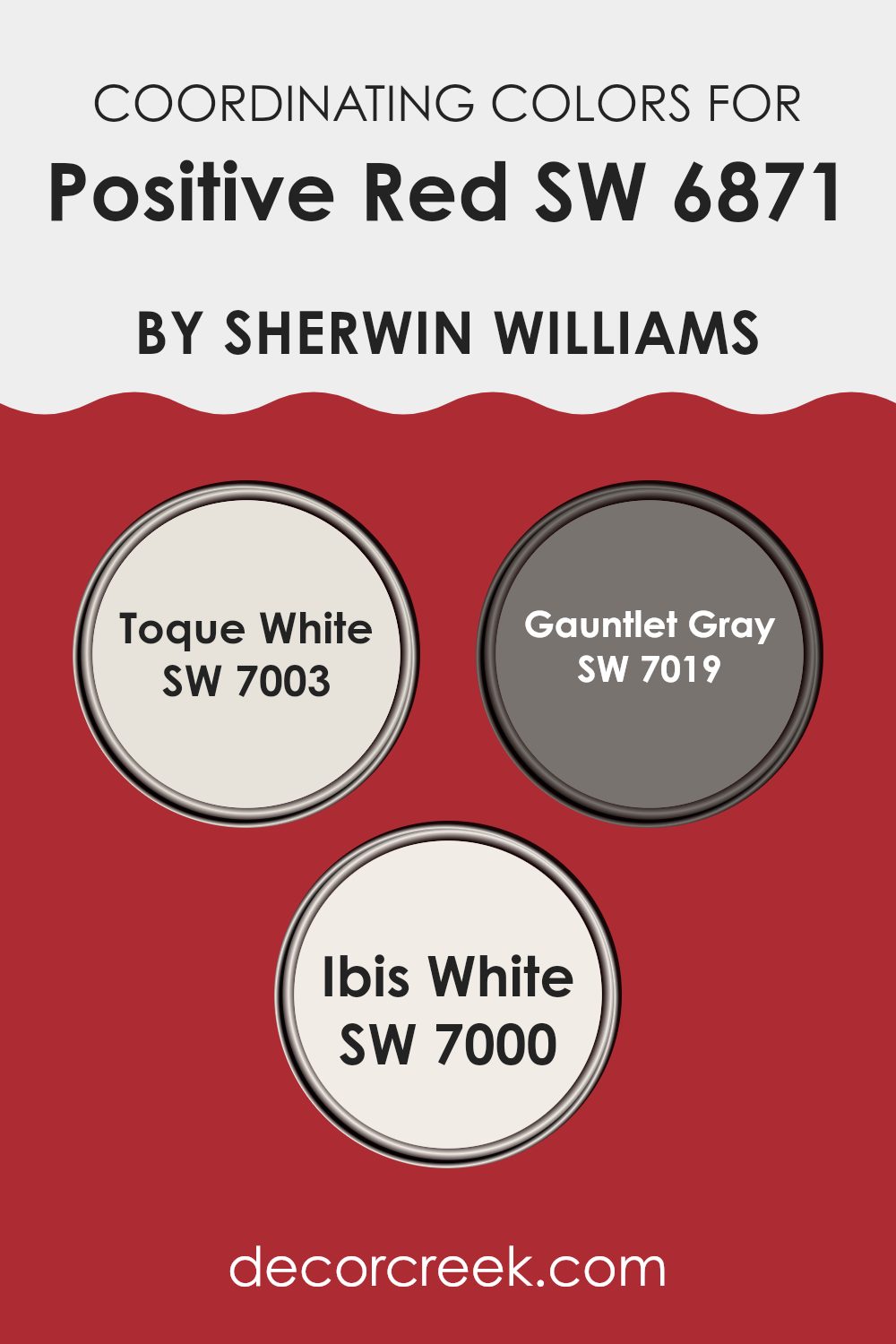
What are the Trim colors of Positive Red SW 6871 by Sherwin Williams?
Trim colors are specific hues chosen to accentuate or complement the main color used on walls, such as Positive Red SW 6871 by Sherwin Williams. These colors, when applied to details like door frames, moldings, and baseboards, create a visual contrast that can enhance the overall appearance of a room.
Choosing the right trim color can highlight the best features of a parts of the home, making it more appealing and harmonious. It’s important to choose trim colors that match the main wall color nicely, so they add to the room’s look without feeling too strong or distracting.
Aesthetic White SW 7035 and Ivory Lace SW 7013 are excellent choices as trim colors for Positive Red. Aesthetic White is a soft and understated white that offers a gentle contrast, thus promoting a cleaner and more defined look against the bold Positive Red.
On the other hand, Ivory Lace is a slightly warmer option that brings a subtle richness and depth to the trim, providing a soft transition that complements the strong presence of Positive Red.
Both colors help in making the main wall color stand out more distinctly, enhancing the overall visual experience of the parts of the home.
You can see recommended paint colors below:
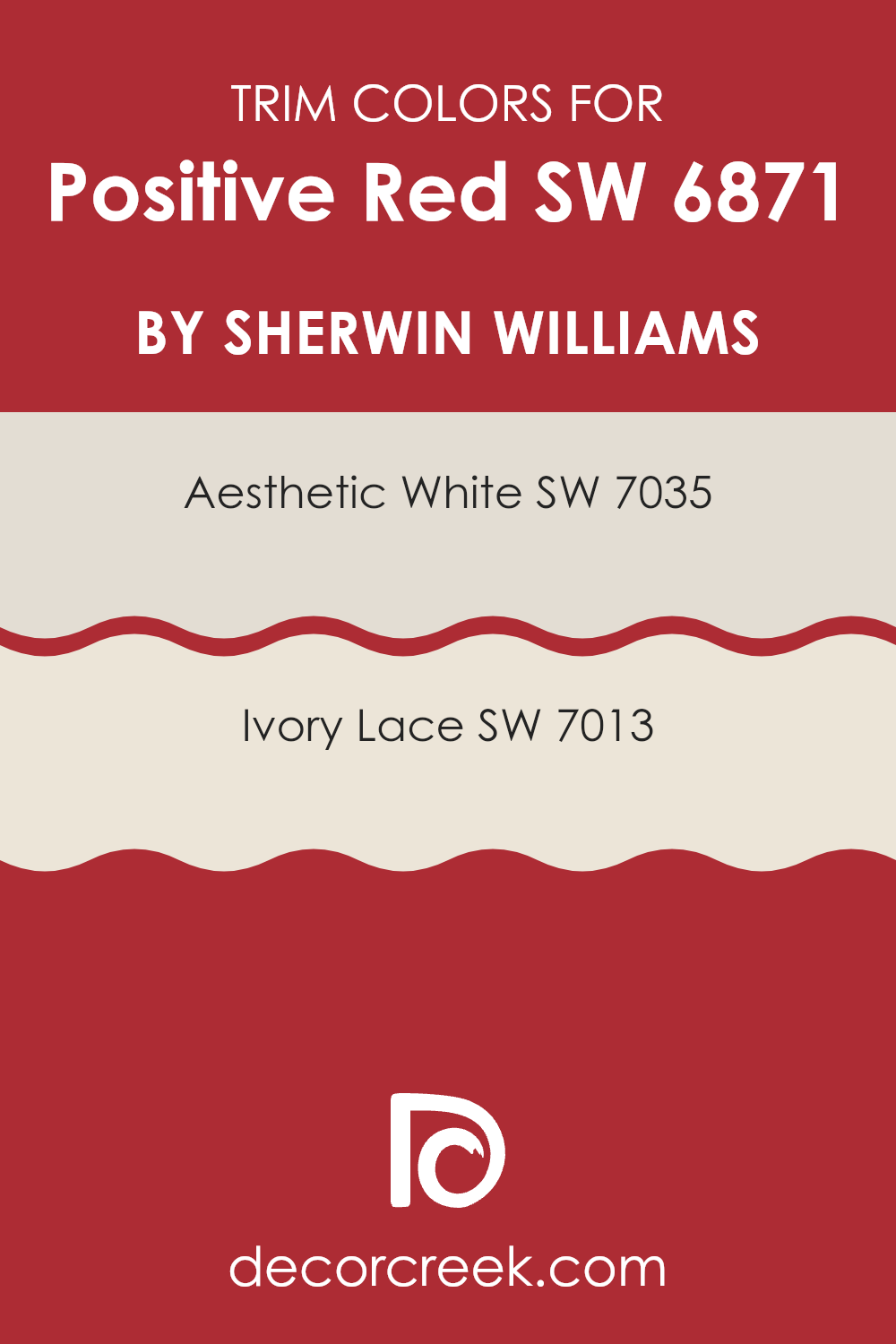
Colors Similar to Positive Red SW 6871 by Sherwin Williams
Similar colors are important because they create a harmonious look while allowing for variety within a single palette. They help design elements to flow smoothly without stark contrasts, which can be pleasant to the eye and create a cohesive atmosphere. For instance, Positive Red and similar shades blend nicely together, but each brings its own mood — making them easy to use in different ways throughout the home.
Real Red is a bold, vibrant color that packs a punch and is perfect for accent walls or furniture pieces that need to stand out. Heartthrob, as the name suggests, is a deep, exciting red that can add a touch of drama and intensity to any parts of the home.
Cherry Tomato is a lighter, more playful red that brings brightness and a youthful energy. Gypsy Red has a slightly muted tone, offering a more relaxed feel but still retaining a strong presence. Tanager is a unique red with orange undertones, ideal for creating a warm, inviting environment. Show Stopper is a deep, rich maroon that provides a classic, elegant backdrop in any setting.
Poinsettia, reminiscent of the holiday flower, carries a cheerful spirit that can liven up a room. Red Obsession is a daring, passionate red that can create a focal point in a minimalist parts of the home. Lusty Red is a darker, seductive shade perfect for intimate rooms or as an accent color.
Finally, Rave Red has a hint of pink, making it soft yet energetic, suitable for rooms that aim to be modern and lively. Each of these colors, while similar to Positive Red, holds its own identity and can significantly influence the mood and style of a part of the home, making them invaluable in nuanced interior design.
You can see recommended paint colors below:
- SW 6868 Real Red (CHECK A SAMPLE)
- SW 6866 Heartthrob (CHECK A SAMPLE)
- SW 6864 Cherry Tomato
- SW 6865 Gypsy Red
- SW 6601 Tanager (CHECK A SAMPLE)
- SW 7588 Show Stopper (CHECK A SAMPLE)
- SW 6594 Poinsettia (CHECK A SAMPLE)
- SW 7590 Red Obsession
- SW 6863 Lusty Red
- SW 6608 Rave Red (CHECK A SAMPLE)
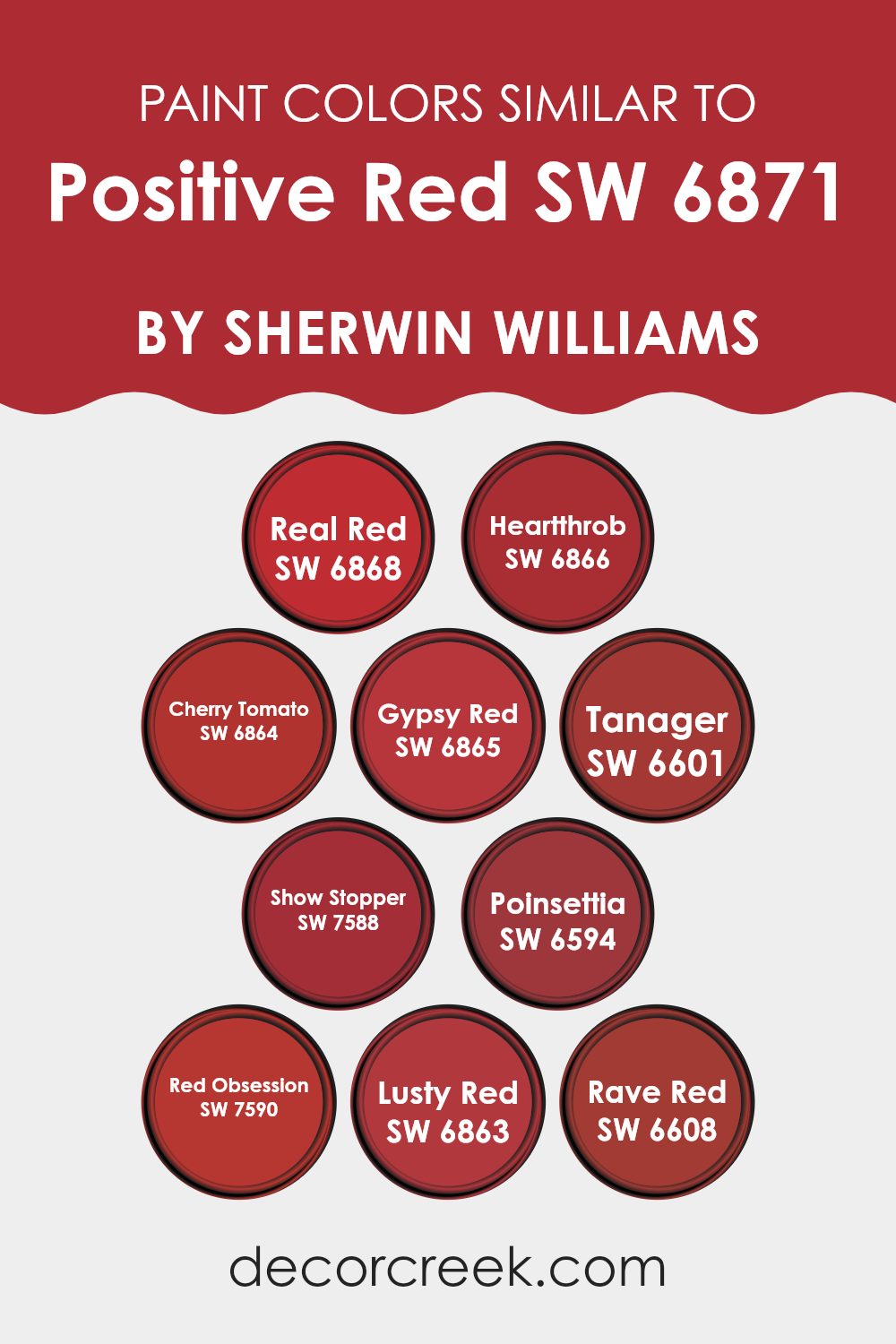
Colors that Go With Positive Red SW 6871 by Sherwin Williams
Choosing the right colors to complement Positive Red SW 6871 by Sherwin Williams is vital because it helps create a balanced and cohesive look in your part of the home. Colors that work well with Positive Red, like Real Red, Heartthrob, Radish, Cherries Jubilee, Exuberant Pink, and Dragon Fruit are bold and vibrant, making them perfect for adding energy and warmth to any room. These colors, when used together, can create a dynamic environment, making interiors more inviting and cheerful.
Real Red is a true, deep red that adds depth and helps ground the energetic tones of Positive Red. Heartthrob is a slightly more vivid red that brings a touch of drama and passion, making it ideal for accent walls or decor items.
Radish offers a lighter, slightly pinkish hue that provides a soft contrast, perfect for smaller elements that need to stand out without overpowering.Cherries Jubilee has a rich, deep tone that plays well with true red — a great choice for bold accents in a living room or dining area.
Exuberant Pink is a bold and bright choice, giving a playful pop of color that works well in creative or youthful interiors. Lastly, Dragon Fruit is a fresh and vivid pink that injects an unexpected twist, making any interior feel lively and modern. Together, these colors support and enhance the qualities of Positive Red, ensuring that any design feels lively yet harmonious.
You can see recommended paint colors below:
- SW 6868 Real Red (CHECK A SAMPLE)
- SW 6866 Heartthrob (CHECK A SAMPLE)
- SW 6861 Radish (CHECK A SAMPLE)
- SW 6862 Cherries Jubilee (CHECK A SAMPLE)
- SW 6840 Exuberant Pink (CHECK A SAMPLE)
- SW 6855 Dragon Fruit (CHECK A SAMPLE)
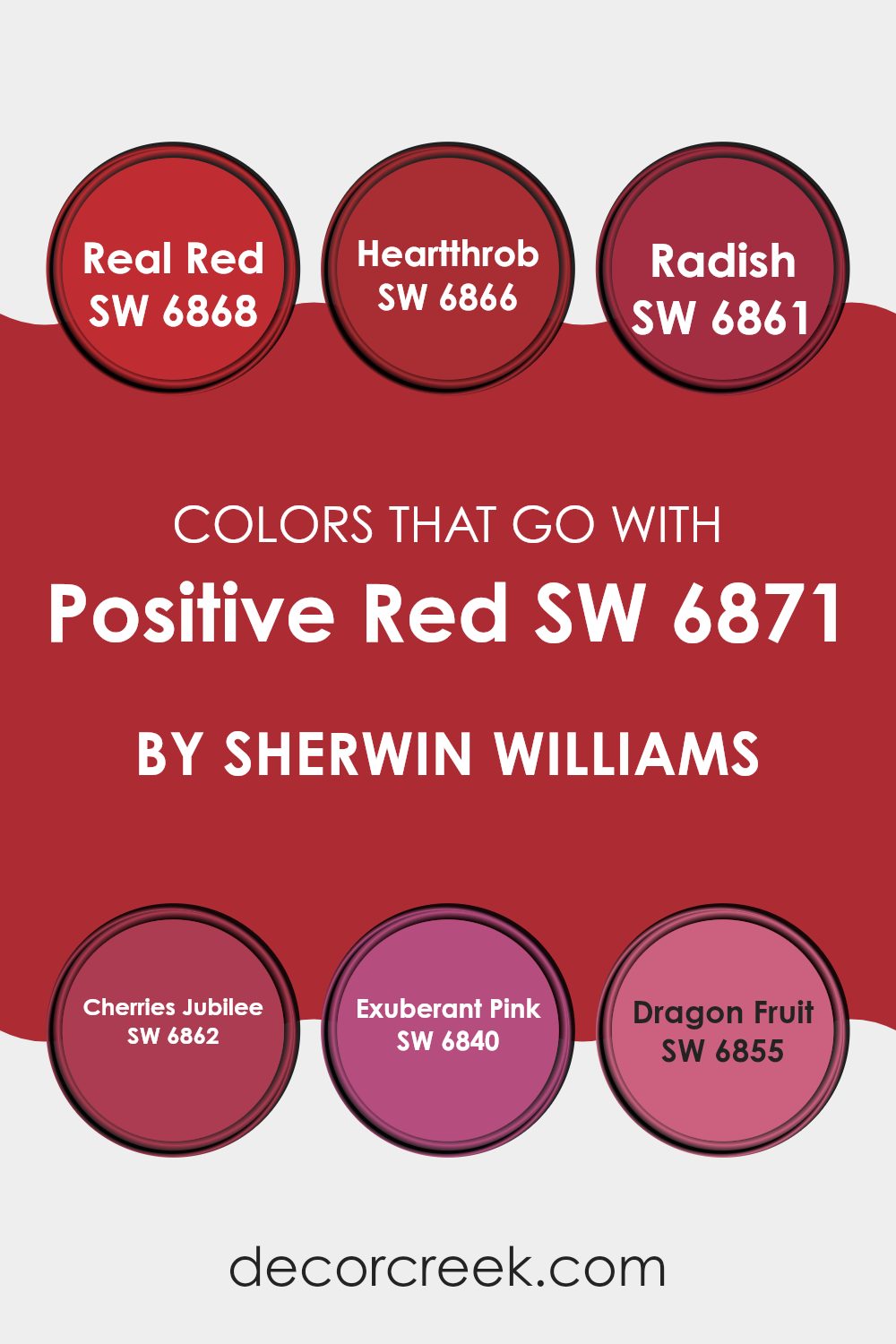
How to Use Positive Red SW 6871 by Sherwin Williams In Your Home?
Positive Red SW 6871 by Sherwin Williams is a vibrant and bold paint color that can bring a lively and energetic feel to any room in your home. This shade of red is perfect for creating a focal point or adding a sense of excitement. You might consider using it on an accent wall in your living room to make the part of the home feel more inviting and lively, which is great for social gatherings or relaxing evenings at home.
In the kitchen, Positive Red can work beautifully on cabinets or a backsplash to create a warm and welcoming atmosphere. This color can also add a touch of fun to a children’s playroom, stimulating imagination and energy.
For those who enjoy DIY projects, Positive Red is a fun way to refresh old furniture or decor pieces, giving them a bold, modern look without making the area feel too intense. Just remember that a little goes a long way with such a strong color, so consider balancing it with neutral tones to ensure your part of the home remains comfortable and pleasing to the eye.
Positive Red SW 6871 by Sherwin Williams vs Red Obsession SW 7590 by Sherwin Williams
Positive Red and Red Obsession by Sherwin Williams are two vibrant shades that each offer a distinct character for home decor. Positive Red is a bright, energetic red that brings a sense of boldness and excitement to a part of the home. It stands out vividly and can make walls or accents in a room pop with enthusiasm – a lively choice ideal for areas where you want to add a punch of color.
On the other hand, Red Obsession has a deeper, more intense tone. This color provides a dramatic flair, lending a rich, warm atmosphere to any room. It’s perfect for creating a cozy and inviting environment, thanks to its deeper hue that feels slightly more grounded than Positive Red.
Whether you choose the striking vivacity of Positive Red or the deep allure of Red Obsession, each shade offers a unique way to enhance your part of the home with the energy and warmth that red tones are known for.
You can see recommended paint color below:
- SW 7590 Red Obsession
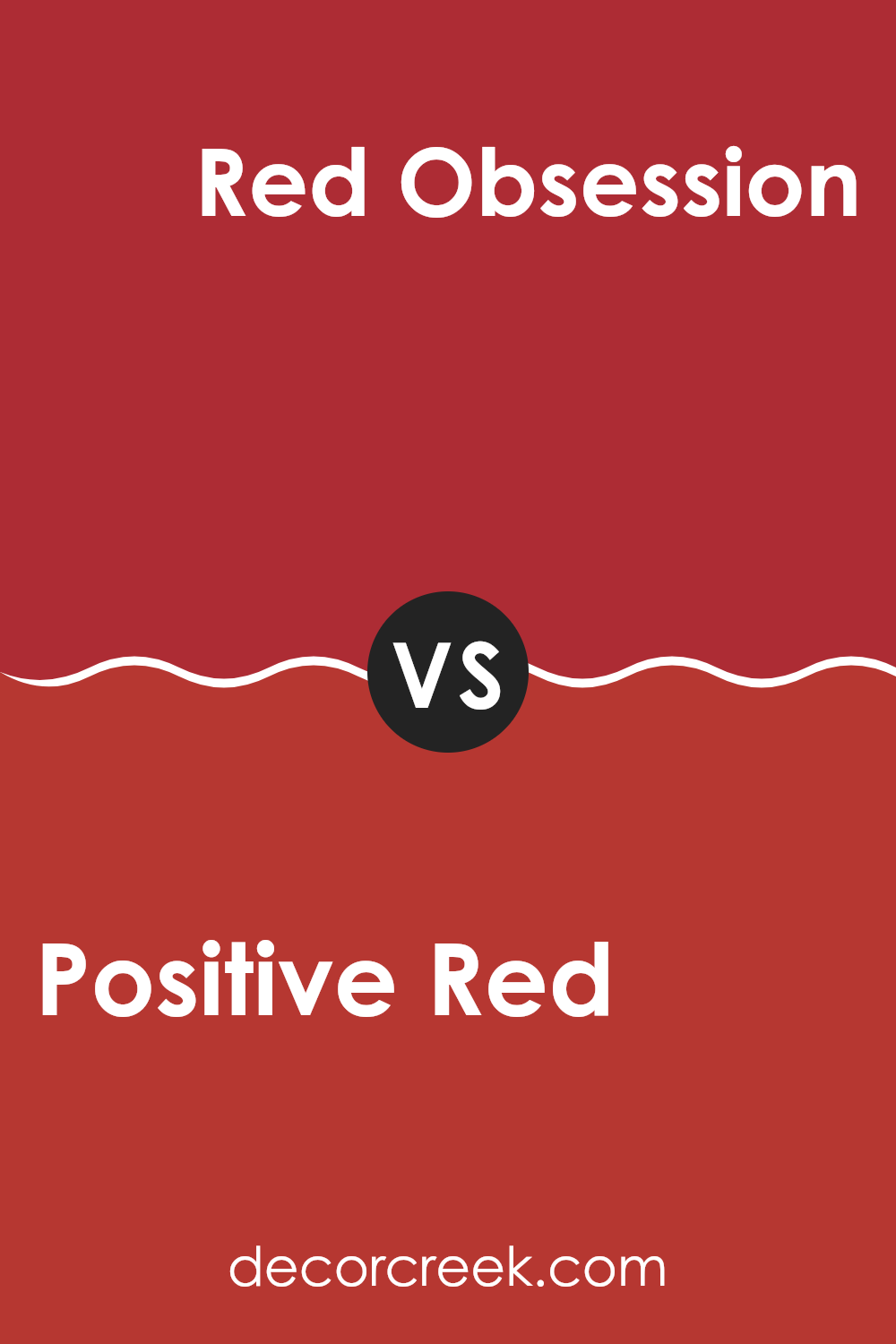
Positive Red SW 6871 by Sherwin Williams vs Rave Red SW 6608 by Sherwin Williams
Positive Red and Rave Red by Sherwin Williams are both vibrant and bold colors. Positive Red is a bright and vivid shade that leans toward a classic red with a slight hint of orange. This color stands out and would be great for interiors where you want to make a strong impression or add a pop of energy.
On the other hand, Rave Red is a deeper red with a hint of cherry undertones. It brings a softer kind of intensity than Positive Red, adding rich color that suits rooms where you want a touch of depth without making the look too heavy.
Both colors are perfect for those looking to add warmth and drama to area. Positive Red is more striking and might suit accent walls or decorative elements, while Rave Red could be better for larger areas or rooms where you want a cozy, inviting atmosphere. Choosing between them depends on the mood you’re aiming to set and how much you want the color to stand out in your decor.
You can see recommended paint color below:
- SW 6608 Rave Red (CHECK A SAMPLE)
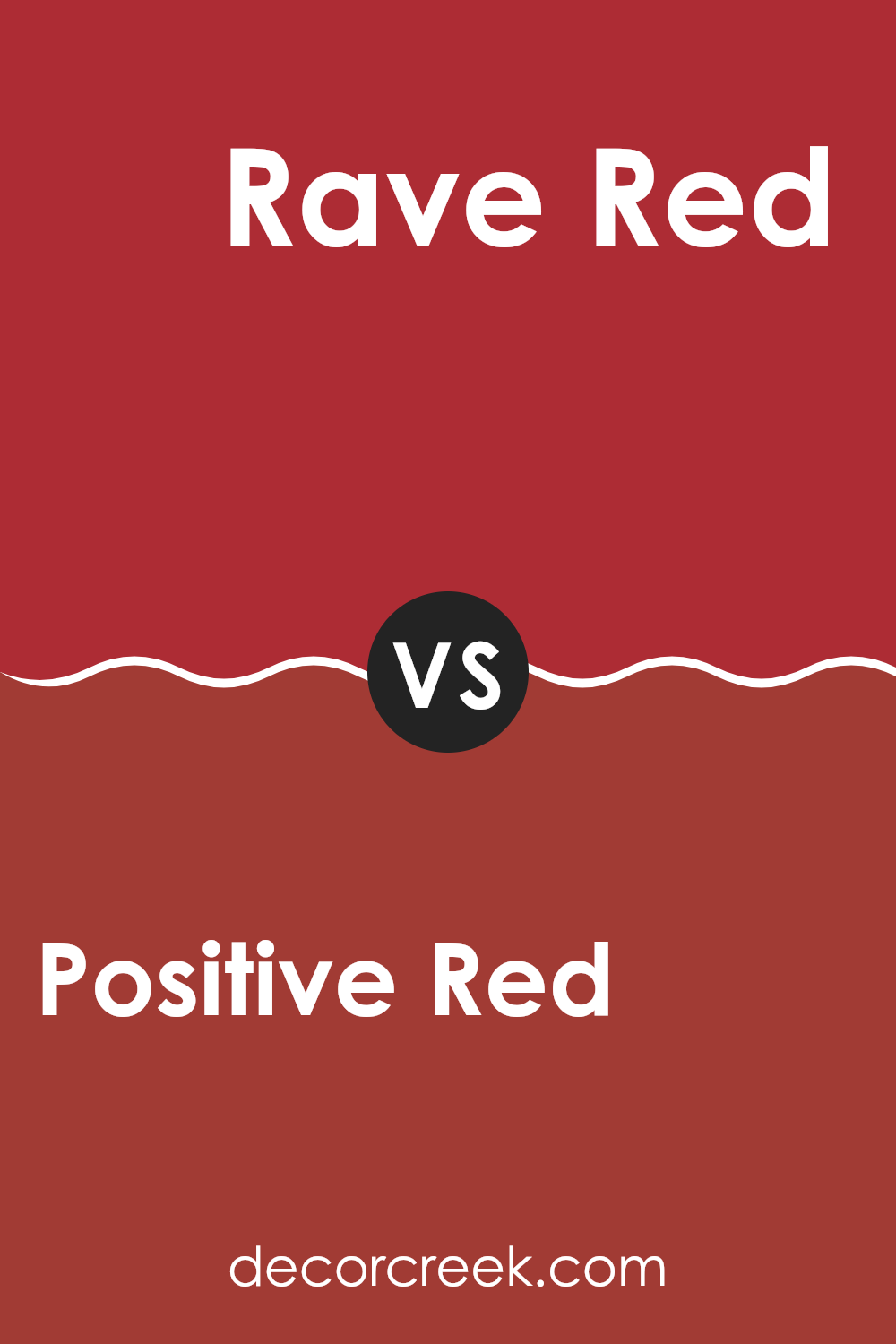
Positive Red SW 6871 by Sherwin Williams vs Gypsy Red SW 6865 by Sherwin Williams
Positive Red SW 6871 and Gypsy Red SW 6865 by Sherwin Williams are both lively, vibrant shades, but they have distinct tones that can create different moods in area. Positive Red is a bright, striking red that packs a punch.
It’s the kind of red that grabs attention and is great for areas where you want energy and enthusiasm. On the other hand, Gypsy Red is a deeper, slightly muted red. This color has a richness that feels warm and welcoming, making it more suitable for cozy, intimate interiors.
When deciding between these two, think about the atmosphere you want to achieve. Positive Red is perfect for a bold, lively look, while Gypsy Red offers a more subdued, comforting aura. Each brings its own unique flair and can dramatically affect the look and feel of a room.
You can see recommended paint color below:
- SW 6865 Gypsy Red
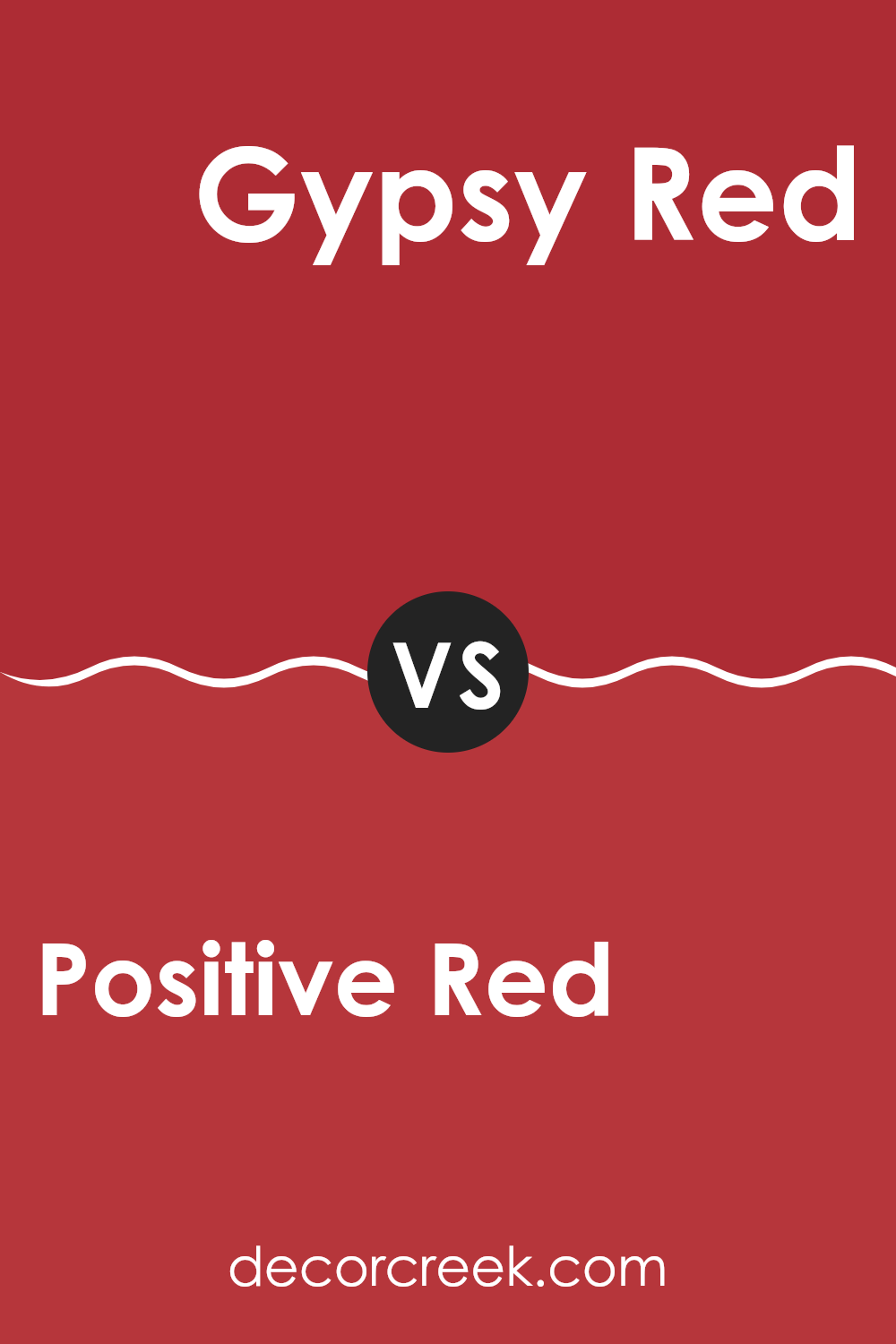
Positive Red SW 6871 by Sherwin Williams vs Show Stopper SW 7588 by Sherwin Williams
Positive Red and Show Stopper are two vibrant shades offered by Sherwin Williams. Positive Red is a bright, cheerful color that leans into a classic red hue which radiates energy and warmth. It’s a great choice for interiors where you want to add a lively and inviting atmosphere, such as living rooms or dining areas.
On the other hand, Show Stopper is a deeper, more intense red. It borders on a burgundy shade, making it appear richer and slightly more reserved than Positive Red. This color works well in areas where a touch of drama and luxury is desired, such as in a home office or a formal dining room.
Both colors are bold and are sure to make a statement, but Positive Red provides a sense of playfulness and brightness, while Show Stopper offers depth and a hint of mystery. Depending on the mood you want to set and the room you’re decorating, either color could be a striking choice.
You can see recommended paint color below:
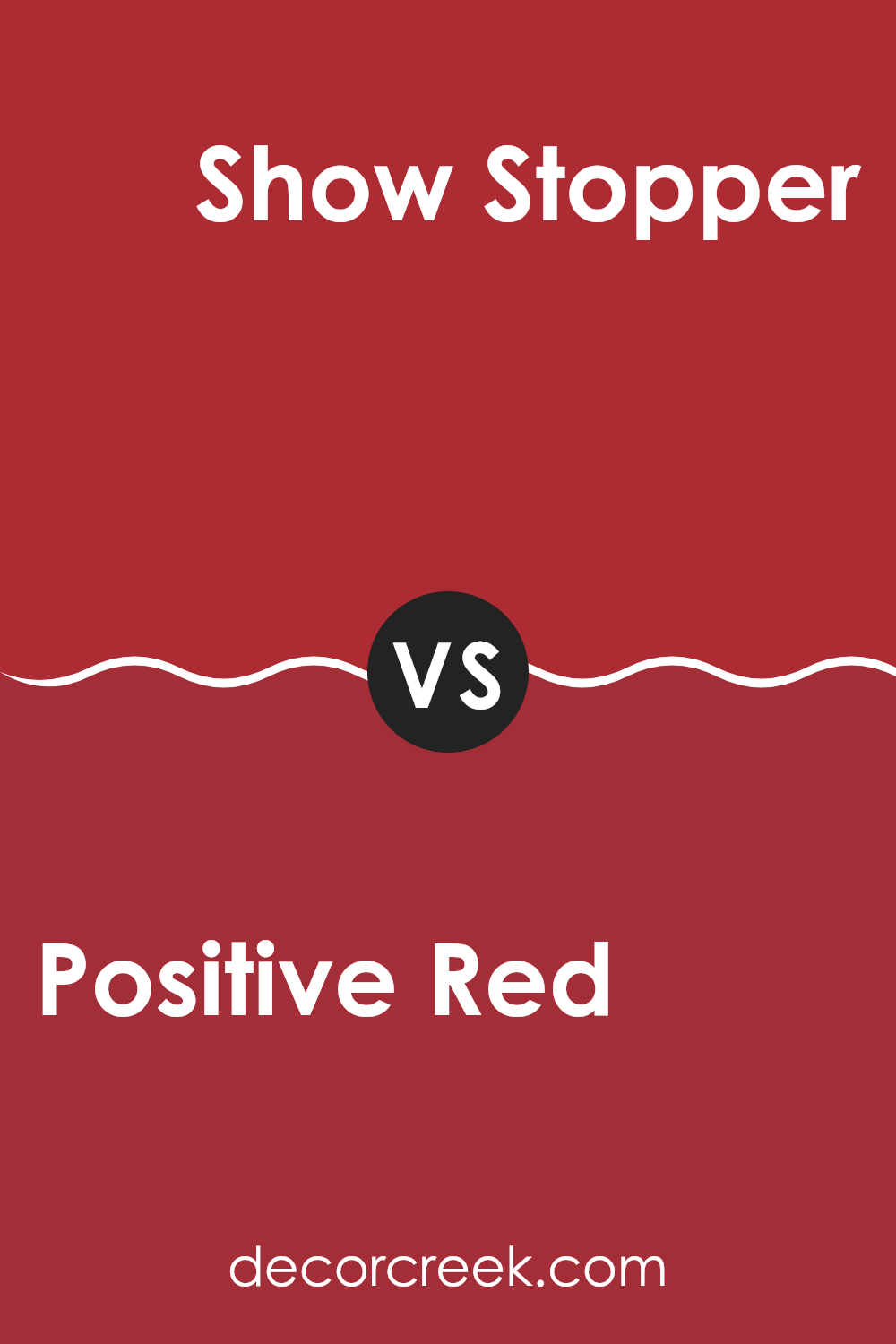
Positive Red SW 6871 by Sherwin Williams vs Tanager SW 6601 by Sherwin Williams
Positive Red and Tanager are two striking colors from Sherwin Williams that offer bold and vivid tones for any area. Positive Red is a very lively and vibrant shade that adds energy and a splash of excitement.
Its brightness is a great choice if you want to create a focal point in a room or stir up some enthusiasm. On the other hand, Tanager is a deep, rich red that leans slightly towards purple. It provides a sense of depth and can bring a cozy and warm atmosphere to any area.
While both colors share a base red, Positive Red is much more intense and outgoing, whereas Tanager offers a moodier, more subtle presence. These hues are perfect for different purposes: Positive Red for areas in need of zest and liveliness, and Tanager for interiors where a more relaxed yet rich tone is desired.
You can see recommended paint color below:
- SW 6601 Tanager (CHECK A SAMPLE)
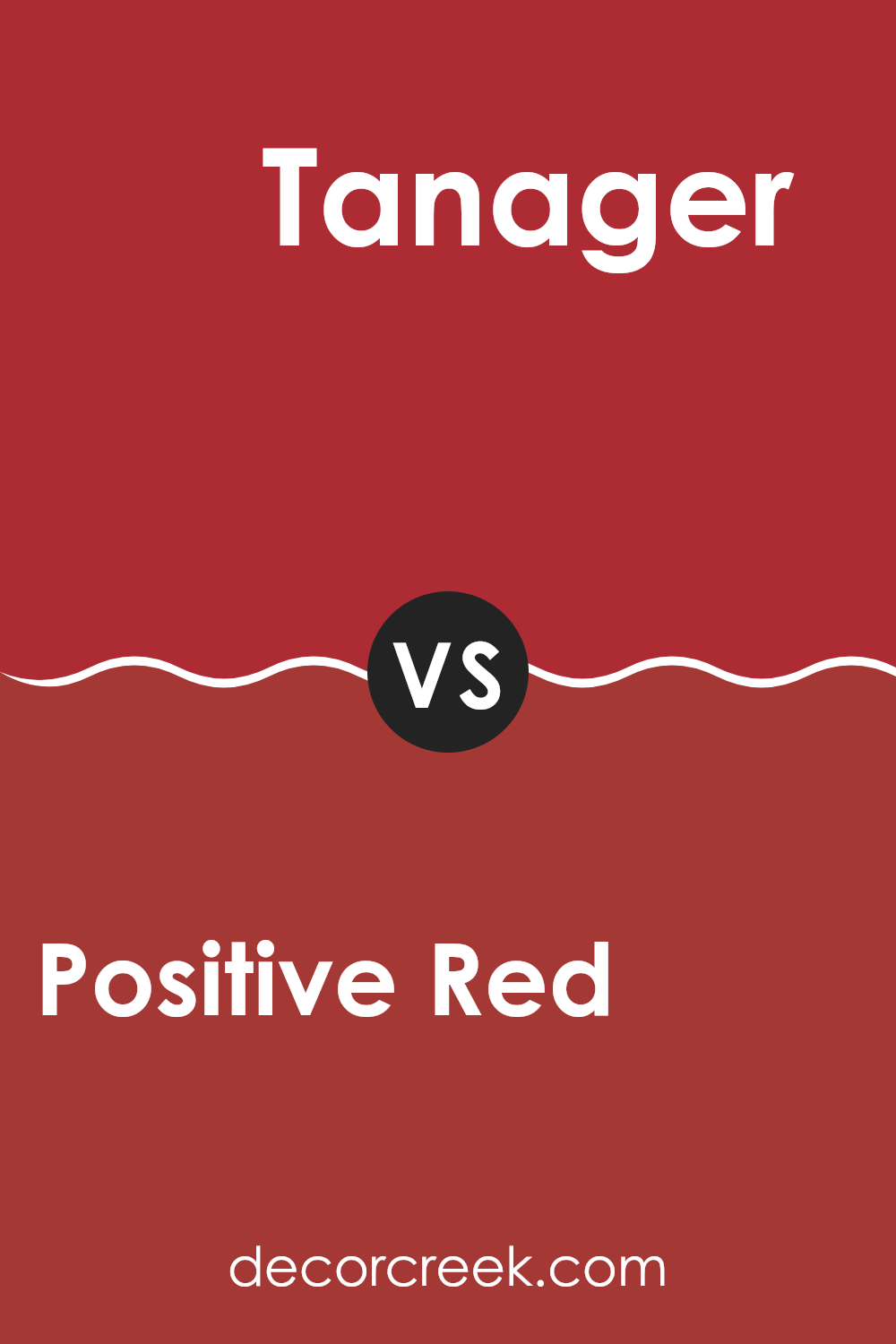
Positive Red SW 6871 by Sherwin Williams vs Cherry Tomato SW 6864 by Sherwin Williams
Positive Red and Cherry Tomato by Sherwin Williams are both vibrant, energetic colors, but they exude different vibes. Positive Red is a classic shade of red with a strong presence. It’s bold and straightforward, making it perfect for interiors where you want to make a statement or boost energy levels, like a dining room or an entrance hall.
Cherry Tomato, on the other hand, leans towards a bright, fiery orange-red. It has a playful and lively feel, perfect for adding a pop of color to modern and casual interiors. This color would work well in a kitchen, playroom, or creative area where you want to stimulate activity and creativity.
While both shades can create a warm, inviting atmosphere, Positive Red has a more traditional red look, whereas Cherry Tomato offers a more youthful and vivid orange tint. Both colors can easily draw attention and are suitable for areas where you want to generate excitement and a sense of action.
You can see recommended paint color below:
- SW 6864 Cherry Tomato
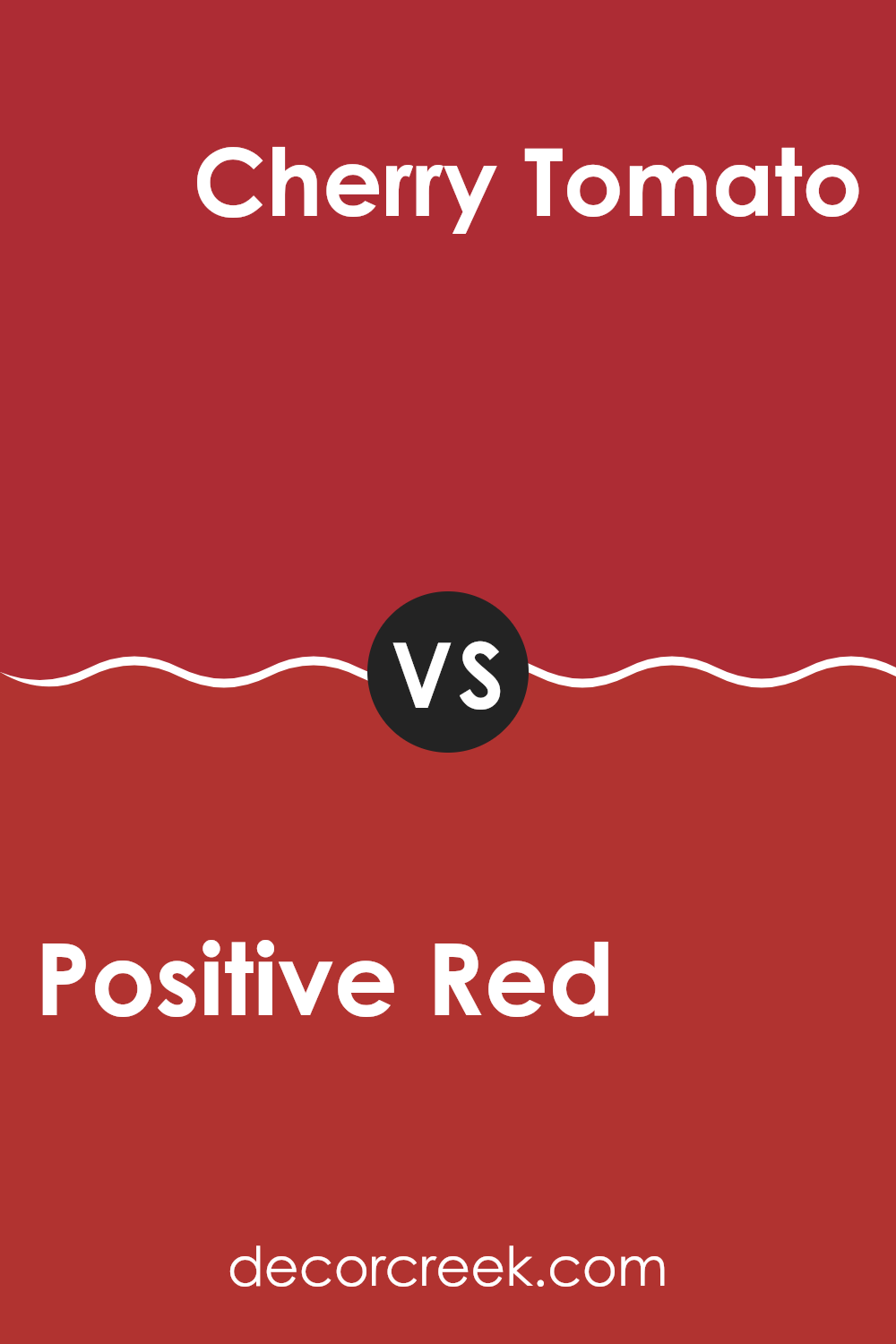
Positive Red SW 6871 by Sherwin Williams vs Heartthrob SW 6866 by Sherwin Williams
Positive Red and Heartthrob are both vibrant colors from Sherwin Williams that bring energy and warmth to any room. Positive Red is a bright and lively red with a punch of intensity, perfect for creating a strong focal point in a room. It’s the type of red that feels dynamic and cheerful, ideal for interiors like a lively kitchen or an energetic hallway.
Heartthrob, on the other hand, is deeper and slightly more muted than Positive Red. It leans towards a rich crimson, which gives it a warmer and less jarring presence in a room. This makes Heartthrob a great choice for areas where you want a bold color that is still cozy and inviting, such as living rooms or bedrooms.
While both shades are red, Positive Red is more eye-catching with its vivid hue, and Heartthrob offers a more intimate and warm feeling due to its deeper tone. Both can make strong statements, but the choice between them depends on the mood you want to set and the room you are decorating.
You can see recommended paint color below:
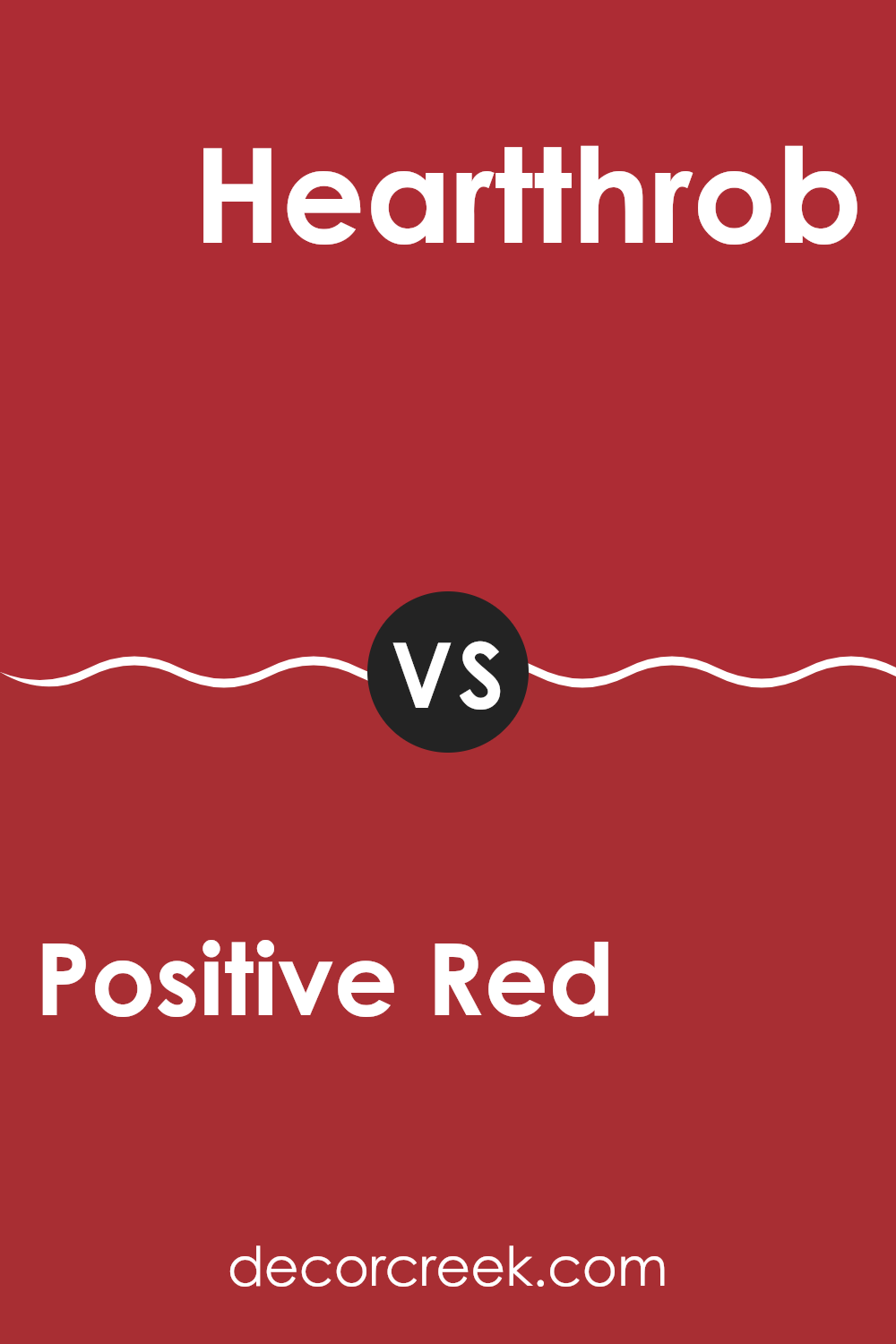
Positive Red SW 6871 by Sherwin Williams vs Poinsettia SW 6594 by Sherwin Williams
Comparing Positive Red and Poinsettia, both from Sherwin-Williams, offers insights into their unique shades of red. Positive Red is a bold, vivid red that commands attention. It’s a pure and strong color that stands out vibrantly in any room. This shade is perfect for areas where energy and excitement are desired, such as a dining room or an accent wall.
On the other hand, Poinsettia is a deeper red with a slightly muted tone. It has a warmer feel, evoking the classic red of holiday poinsettias. This color is softer than Positive Red, which makes it easier to use across more areas of the home. It can create a cozy, inviting atmosphere, suitable for living rooms or bedrooms where a softer, yet still rich, color is preferred.
In summary, while both colors share the warmth and energy of red, Positive Red is sharper and more striking, whereas Poinsettia offers a gentler, welcoming warmth that’s easier to blend into various decor styles.
You can see recommended paint color below:
- SW 6594 Poinsettia (CHECK A SAMPLE)
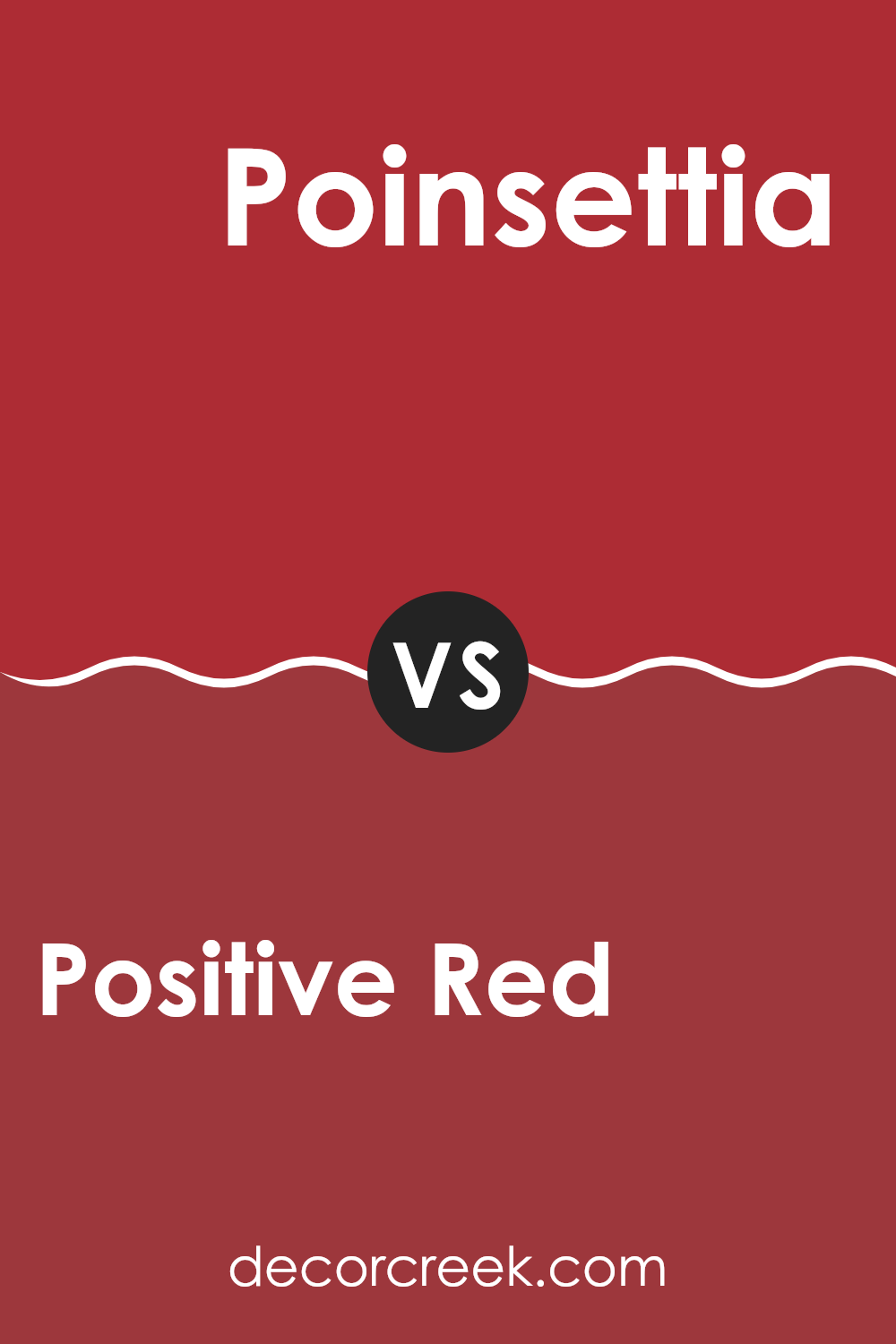
Positive Red SW 6871 by Sherwin Williams vs Real Red SW 6868 by Sherwin Williams
Positive Red and Real Red by Sherwin Williams are both vibrant and bold colors, but they have subtle differences in hue and tone that distinguish them from one another. Positive Red has a slightly more orange undertone, making it appear warmer and more inviting. This warmth makes it an excellent choice for interiors where a friendly and energetic atmosphere is desired, like living rooms or dining areas.
Real Red, on the other hand, is a purer red, incorporating less orange and presenting a more classic red look. This shade is vivid and striking, offering a bolder statement that can be great for accent walls or areas where you want to draw attention immediately.
Both colors are bright and can energize room, but the choice between them depends on the specific mood or style you want to achieve. Positive Red, with its warmer undertones, can create a cozy feel, while Real Red provides a more straightforward and bold visual impact.
You can see recommended paint color below:
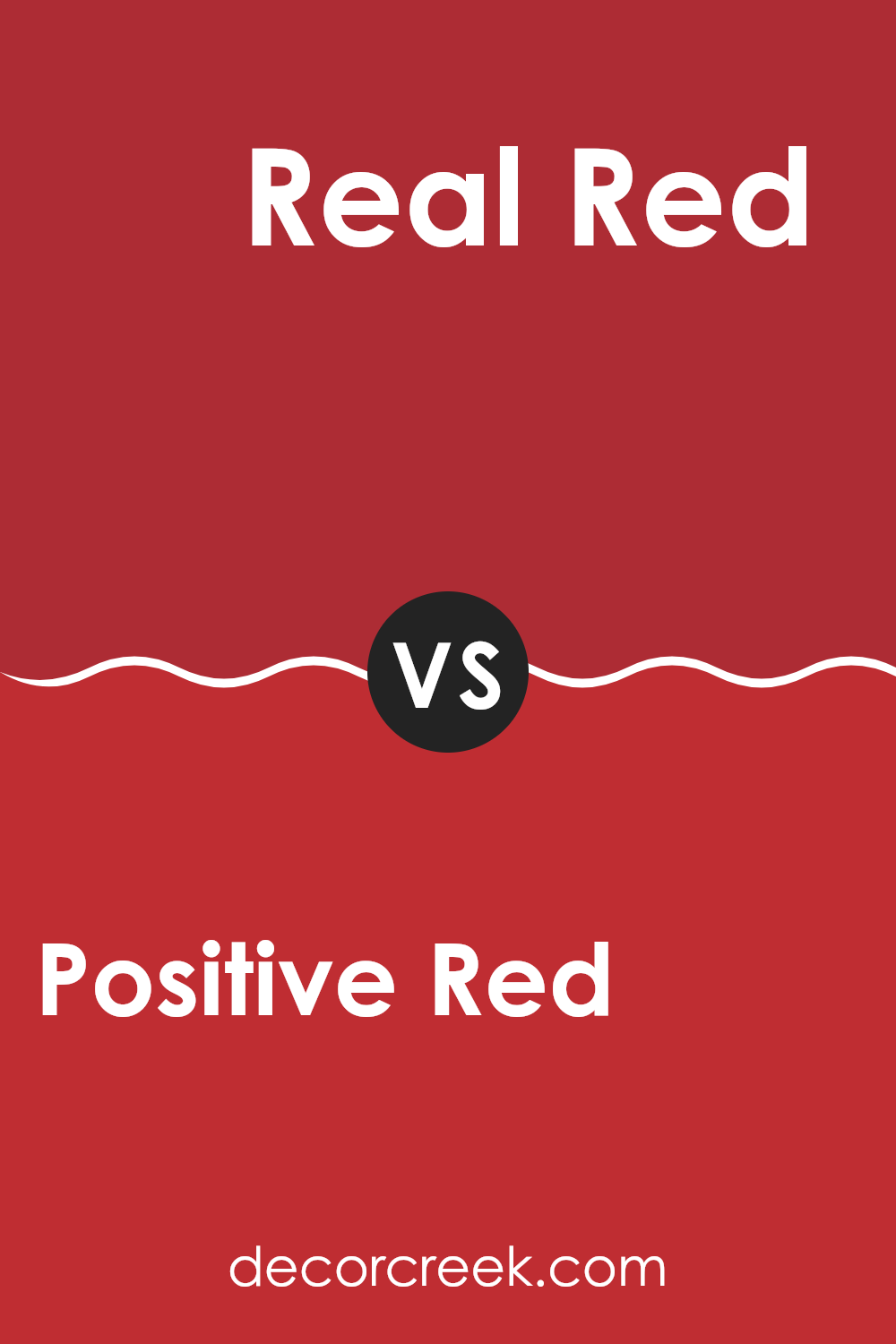
Positive Red SW 6871 by Sherwin Williams vs Lusty Red SW 6863 by Sherwin Williams
Positive Red and Lusty Red by Sherwin Williams are two vibrant shades that add personality and energy to any spot. Positive Red is a bold, bright red with a slight hint of orange undertones, making it a lively choice that pops in any setting.
It’s great for creating a focal point or adding a playful touch. On the other hand, Lusty Red is a deeper, more intense shade. This color has a richness that leans a bit towards maroon, giving it a warmer feel. Lusty Red is perfect for adding depth and warmth to a room, making it ideal for cozy, intimate interiors.
When choosing between these two, consider the mood you want to set: Positive Red is more energizing and stands out, while Lusty Red offers a more grounded and comforting atmosphere. Both colors are sure to make a strong statement.
You can see recommended paint color below:
- SW 6863 Lusty Red
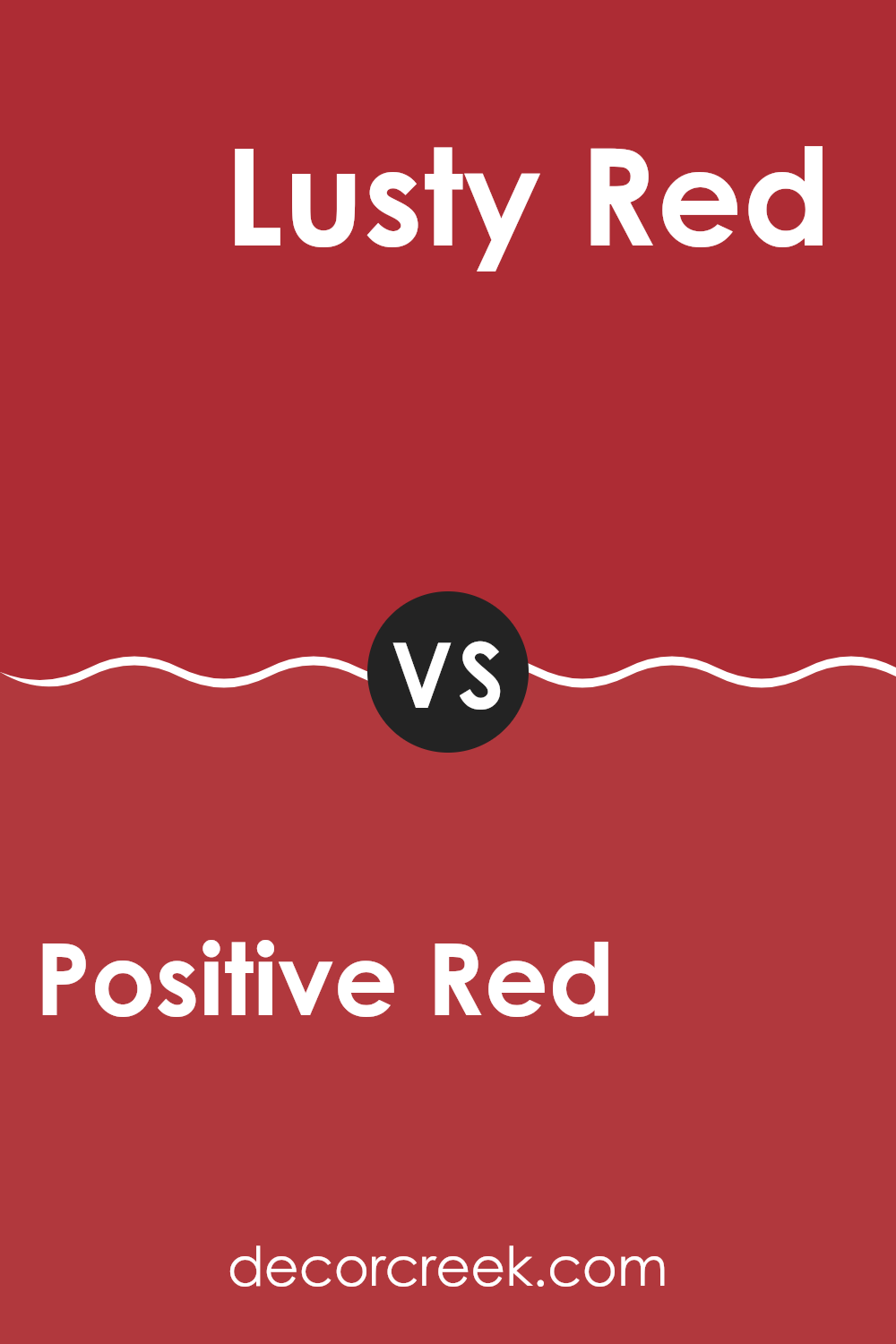
SW 6871 Positive Red by Sherwin Williams is definitely a bold and lively color choice. After looking closely at this paint, I’m really impressed by how it can brighten up a room and make it feel cheerful. This color is super bright, kind of like the red you see on fire trucks. It’s perfect for spots in a home that you want to feel energetic, like a playroom or maybe an accent wall in the living room.
The paint goes on smoothly and covers the walls well, so you won’t have to worry about it looking patchy. Plus, it seems to hold up well over time, which means you won’t have to repaint it often. That’s pretty handy!
To sum it up, Positive Red by Sherwin Williams is an excellent pick if you want to add a splash of energy to your home. It’s especially great if you’re tired of dull colors and want something that stands out. If you’re thinking of adding a pop of color to your room, this red might just be what you’re looking for!
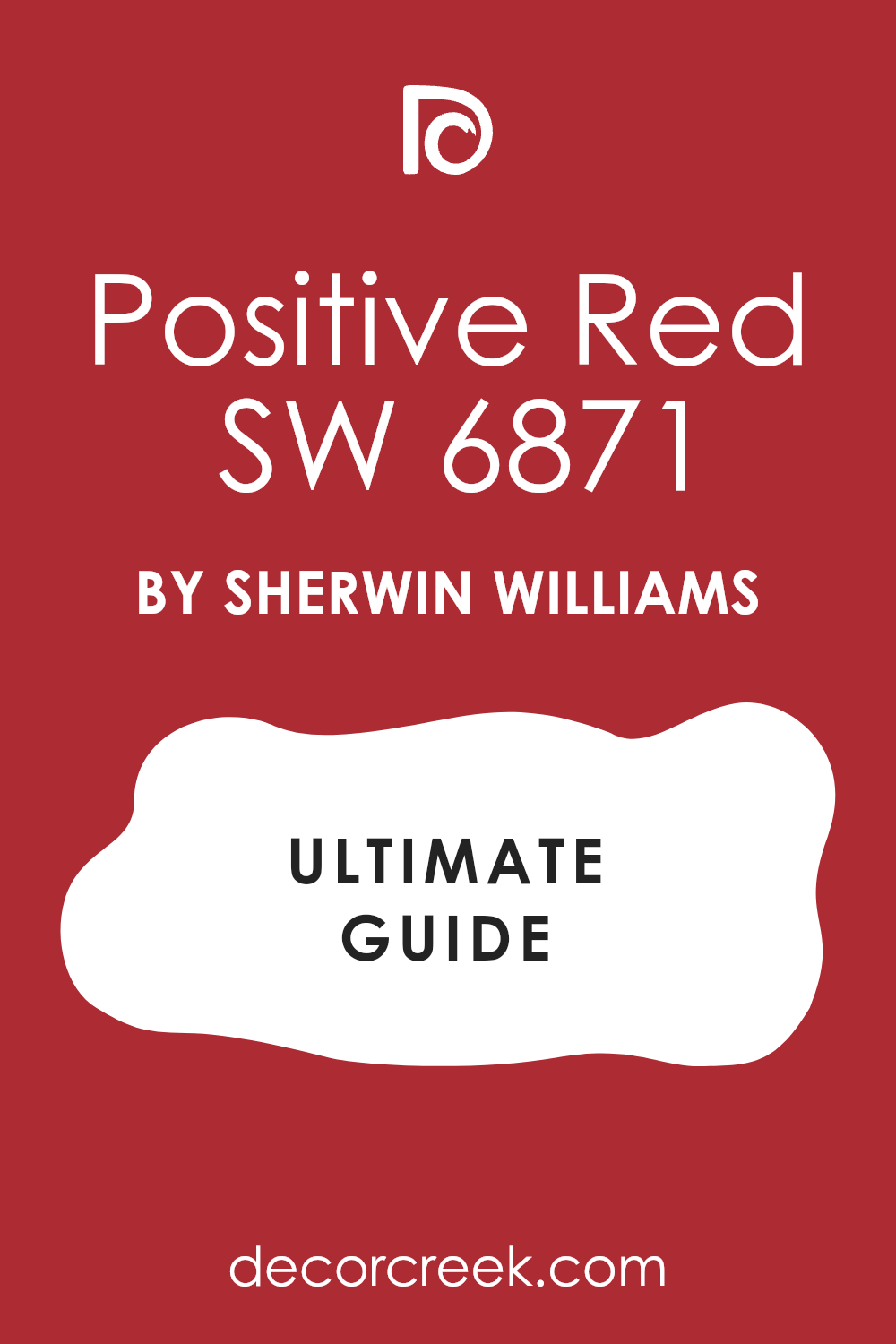
Ever wished paint sampling was as easy as sticking a sticker? Guess what? Now it is! Discover Samplize's unique Peel & Stick samples.
Get paint samples



